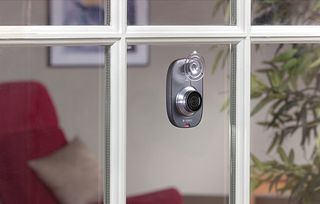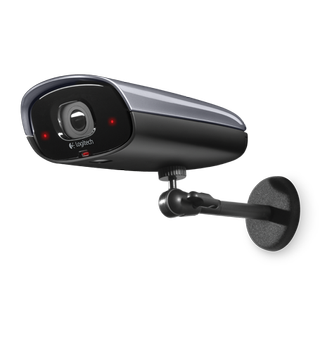PC-Based Home Security: Do It Yourself
We test products that let you monitor and protect your home without the need for an outside security company's services: D-Link, Axis, Logitech, Schlage
Logitech Alert 750i and 750e
I was using WiLife security cameras long before Logitech acquired the company and rebranded the products. I enjoyed the WiLife products then, but I like the new Logitech Alert models a whole lot more. The product series was in desperate need of an overhaul, and, in typical Logitech fashion, the results managed to exceed most of our expectations.

Here’s the Logitech Alert 750i Master System ($299.99; $229.99 for 700i add-on). Essentially, it’s an indoor camera, cabling, HomePlug powerline wall adapter, three types of camera mounts, a 2GB SD card, and software. Unlike many consumer cameras, this mouse-sized 750i feels solid in the hand. The included flat Ethernet cable clicks into a port hidden behind a detachable panel in the camera’s back. At first, I wondered, “Why a flat cable?” Then, when I went to route the cable from the camera on my window sill down to the HomePlug wall wart, I quickly realized how much easier flat cables were to tuck into crevices and run under objects. Smart!

For mounting, Logitech includes a cradle, a stand with multi-directional head, and a window suction cup. Judging by Logitech’s model photography, these three options look oh so stylish—except for Logitech apparently airbrushed the requisite power/data cable from each image. These cameras are neither wireless nor battery-powered, so keep the cabling in mind as you plan how and where to place your units. Also note that Logitech’s integrated microphone didn’t perform as well for me as the D-Link or Axis units, so if sound is important, get closer to where you anticipate the action will be. Audio is one-way only; there are no speakers in the cameras.
If you want the outdoor camera, you’re dealing with either the 750e Master System ($349.99) or the 700e Add-On Camera ($279.99), which requires a Master System to already be on the network.

The 750/700e is built like a tank. The metal housing is thick, the Ethernet cable slips inside of a compartment secured with two screws, and it feels like it will laugh in the face of global climate change. The outdoor cam also sports a microphone and has two infrared emitters flanking the lens to help with night vision. In total darkness, the IR lamps will push visibility out to 20 to 30 feet.
The old WiLife outdoor camera was all but useless to me. I wanted to mount it under my eaves above the garage, but its conventional power cable would have meant running an extension cord up the side of the house all year, and I’m not sure data would have run reliably over that. The new Alert models both seem much better able to maintain solid connections and frame rates at my house’s outermost outlets. I wonder if this has to do with Logitech’s move to the HomePlug standard on the Alert models. In any case, if Logitech’s included cable is too short for such a lofty reach (which it is), simply get a high-grade Ethernet cable for the connection. The weather-proofed wall adapter stays at your outlet down by the ground.
Sign up to get the BEST of Tom's Guide direct to your inbox.
Get instant access to breaking news, the hottest reviews, great deals and helpful tips.
I should point out here that the Logitech Alerts are not conventional IP cameras. They are HomePlug cameras that route data across your building’s electrical wires, not Ethernet. The Ethernet cables I’ve mentioned serve only to go from the camera to the wall adapter and from a second wall adapter (included with Master Systems) to your router. All other connections run through the power lines in your walls. This excludes the Logitech cameras from intermingling with most other IP camera systems, but for the consumer market, most of which lacks Ethernet structured wiring and may have spotty wireless performance, this is a calculated risk on Logitech’s part that makes a lot of sense.
Current page: Logitech Alert 750i and 750e
Prev Page Security Monitor Pro Next Page Logitech’s Alert SoftwareWilliam Van Winkle is a freelance editor and tech journalist who has been writing for more than 20 years. His work has appeared on Tom's Guide, Tom's Hardware, Tom's IT Pro, AMD, Seagate, Computer Shopper, and more. He is also an author, writing poetry, short stories, and science fiction and fantasy books.
-
thegreathuntingdolphin William,Reply
Cool article. I have been looking into security cameras for the home, especially ones that are outdoor or pointed outdoor (some noobcakes have been hitting cars and driving off in my apartment complex). I am a bit dissapointed that most of these don't really seem good for outdoors or for long distance night recording (I know some of these said up to 20 to 30 feet but in my experience that means they are really only clear at 10-15 feet). Foscam has a number of cheap IP cameras with pan and tilt, are for outdoor use or longer night vision use. Do you have any experience with them?
The Schlage system is looking good. Hopefully others will jump on the bandwagon and get more products out. I am glad the Schlage deadbolt is not motorized like the Kwikset one since it greatly improves the battery life. Whenever I get a house I am definitly going to do something like the LiNK system.
I too am disappointed in the current IP-based offerings. The perfect IP-based camera seems illusive. Too many have half the features. Most the N wireless ones seems to lack really good night vision capabilities and the ones with good night vision capabilities usually are G only or have N are stupidly expensive. -
Nice article!Reply
It’s interesting how IP cameras and emerging technology, such as Jabbakam.com enable average people to transform a home surveillance system into a shared camera network that can be accessed by whoever is invited by the camera owners, to view the footage via an online account accessible from anywhere at anytime.
Jabbakam is a system where you have complete access to your footage, to manage and share as you want. You can easily create a network (public or private) and invite your friends or neighbours to join and add their cameras so that you all have access to the footage of the cameras as a group.
You can set up alerts so that you will be notified by email or sms if your camera detects something happening in front of it, and you have peace of mind that your camera is doing its job and working, thanks to a monitoring system that checks your camera status every few minutes. The Jabbakam website offers users a lot more functionality besides. Check us out, and join us on Facebook.com/jabbakam and Twitter (@jabbakam). We’d love to hear from you! -
It is still an annual subscription of $80 a year it is only very well hidden by Logitech (just try and buy it and you will figure it out).Reply
The hiding of subscription cost itself is terrible, but also that they sell you just part of a product is outragous. It makes me mad and takes some of the joy of owning such a cool (and expensive) product. -
I'll never buy a product that requires a subscription or is dependent on another site or "the cloud". Excellent article, except for the WPS thing.. WTH is that?Reply
